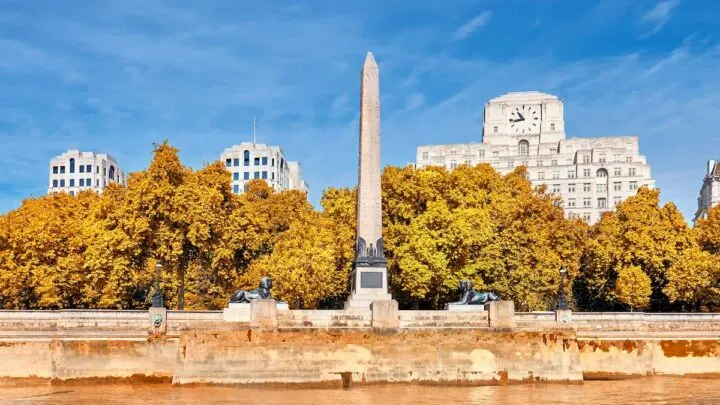An Egyptian obelisk on the shores of the Thames at Embankment? Cleopatra’s Needle may well be London’s strangest landmark.
When we first stumbled across Cleopatra’s Needle, we had to do a double-take – it might just top the list of random London landmarks that barely make any sense.
Which is saying a lot really, as the capital is filled with so many weird and wonderful things to see and do.
But what exactly is this Egyptian obelisk for? And why on earth is it in London?
If you’ve never heard of Cleopatra’s Needle, allow us to explain it all. And make sure you stick around for some interesting little facts at the end.
Wait, What is Cleopatra’s Needle?
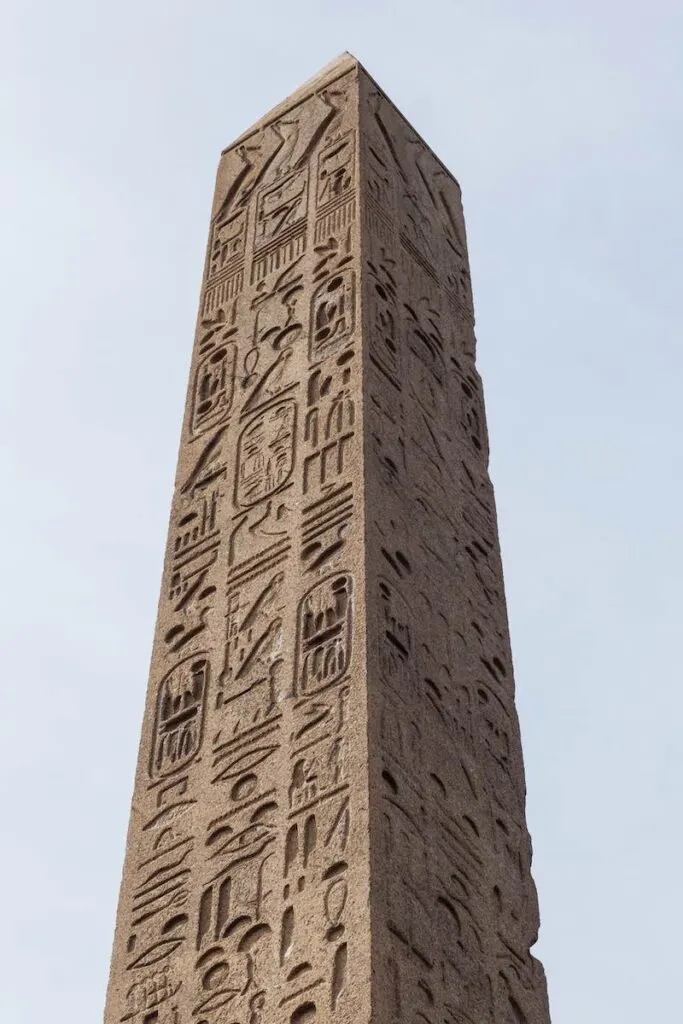
Cleopatra’s Needle is situated on the Victoria Embankment, smack bang between Waterloo Bridge and Golden Jubilee Bridges.
Standing at 21 metres tall and weighing a hefty 224 tons, the Egyptian obelisk is covered in ancient hieroglyphs and overlooks the Thames.
It was first gifted to the UK by the ruler of Egypt and Sudan, Muhammed Ali, in 1819 as a nod to the victories of Lord Nelson and Sir Ralph Abercromby at the Battle of the Nile and the Battle of Alexandria, respectively.
The History of the Obelisk
Egyptian Beginnings
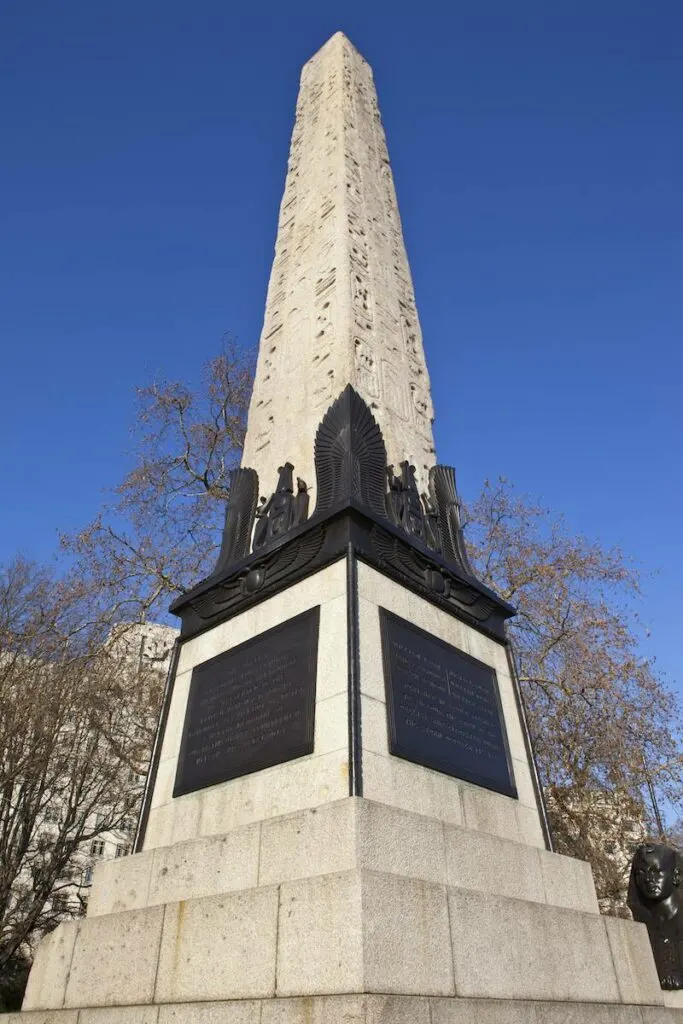
The relocation of the obelisk might seem a little random, but Cleopatra’s Needle has a long and fascinating history that led to it eventually being sent to London from Alexandria (which was known as the royal city of Cleopatra).
It was created from granite (sourced from near the Nile) for Pharaoh Totmes III in 1460 BC and used to stand in Heliopolis.
Originally, the obelisk had only one block of text on each side, with other inscriptions on either side of the original ones added in later years by Ramesses II to highlight his important victories as Pharaoh.
In 12 BC, the Needle was moved to Alexandria inside the Caesareum – a temple built by the Romans at the request of Cleopatra.
It, and its twin obelisk that now stands in New York City, were pulled down in later years, though. This provided them with a stroke of luck; it helped to preserve most of the hieroglyphs and prevent them from weathering away.
Cleopatra’s Needle Comes to London
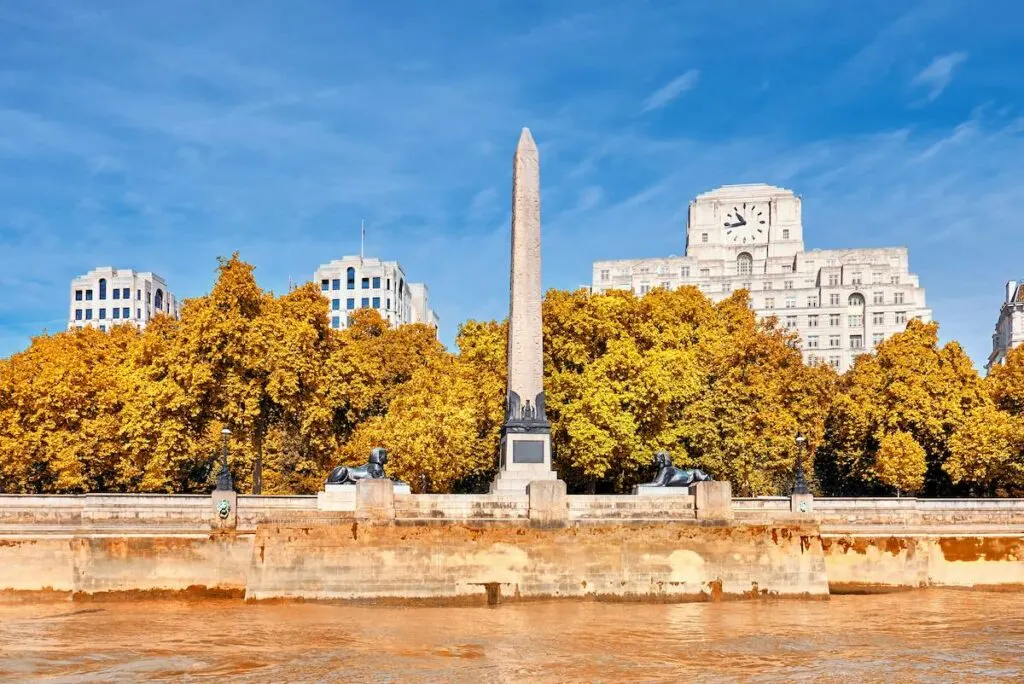
Okay… but how on earth did they haul it over to London?
Fast forward a few hundred thousand years and one of Cleopatra’s Needle was to be given to the British.
While the government of Lord Liverpool was flattered by the gift, they decided that they did not want to fund the obelisk’s long and arduous transportation to London (charming, really).
It wasn’t until 1867, however, when James Edward Alexander visited Concord in Paris that he decided that London was bereft without a colossal Egyptian obelisk.
He had heard that the owner of the land in Alexandria (where the British Needle was situated) intended to break Cleopatra’s Needle up and use it as building material. Curiosity piqued, Alexander got his mates on board, and together they funded the cost of shipping the Needle to London.
And so the Needle’s horrific journey by sea began in 1877.
The Voyage from Hell
Manned by a crew of Maltese sailors, the needle was encased in an iron cylinder that was then fitted with a deckhouse, mast, rudder and steering gear. This makeshift craft was called ‘Cleopatra’ and was towed by the steamship ‘Olga’.
After becoming stranded somewhere near Spain, Olga’s skipper dispatched members of his crew to rescue sailors from Cleopatra.
Sadly, the rescuers perished, and today their names are commemorated on plaques at the base of the obelisk in London today. The sailors from the Cleopatra were rescued and taken to safety near the Bay of Biscay. It was initially assumed in London that the Cleopatra had sunk, yet news of a sighting by Spanish trawlers made its way to England.
It took a while for the obelisk to arrive in London, eventually arriving on the Thames in September 1878. After a perilous voyage, the government could finally breathe a sigh of relief as Cleopatra’s Needle was winched into the very same position it still stands in today.
What You Need to Know: Quirky Facts About London’s Most Famous Obelisk
There Are Actually Three Needles (Although Only One in London)
There are three famous Cleopatra’s Needles across the globe. The Obelisks in London and New York are a pair, while the one in Paris has a twin in Luxor in Egypt.
Cleopatra’s Needle is Flanked by Two Sphinxes
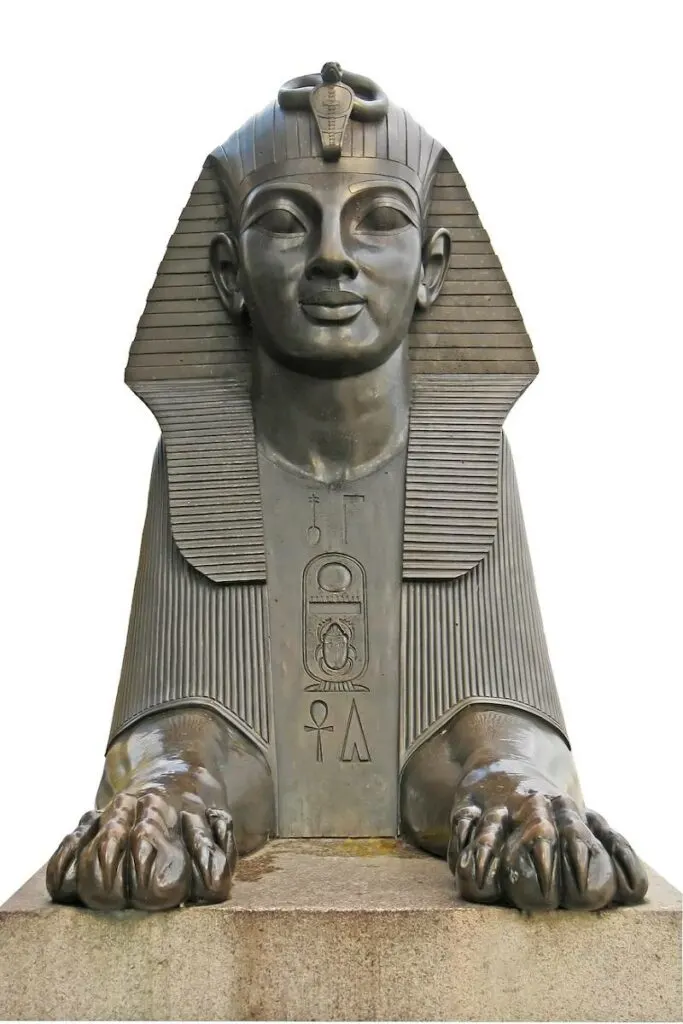
If you look closely at Cleopatra’s Needle, you’ll find that the obelisk is flanked by two bronze Egyptian sphinxes designed by the British architect George John Vulliamy.
Look even closer and you’ll notice that the cats are facing the wrong way – this is believed to be due to an error during the installation.
Decorating the cool cats is a pair of hieroglyphic inscriptions reading “Netjer nefer men-kheper-re di ankh” which translates to “the good god, Thuthmosis III given life”.
There’s a Time Capsule Buried Under The Obelisk
Believe it or not, there’s actually a treasure trove buried deep underneath the Needle.
When the obelisk finally arrived in the capital, the Victorians decided to mark the occasion by planting a time capsule.
While we don’t recommend digging it up (you might just end up being thrown in the Tower of London), it’s said there are children’s toys, razors, railway books, copies of the Bible, a portrait of Queen Victoria, and, most bizarrely, 12 paintings of ‘pretty ladies’ that were hand-picked by Captain Henry Carter*.
*Captain creepy, more like.
The Ship Carrying The Obelisk Was Immediately Destroyed
After what can only be described as a horrendous journey across the globe, the ship carrying the Needle was disassembled immediately after Cleopatra’s Needle was removed from it on the 6th July 1878.
It was probably for the best.
The Obelisk was Bombed During World War I
On 4th September 1917, less than forty years after the obelisk arrived in London, the German air force carried out an air raid on London. A bomb thrown from a raiding bomber landed near the needle, causing damage to the ancient obelisk.
By way of commemorating the raid, the damage was unrepaired and remains visible in the guise of shrapnel holes on the right of the two sphinxes. The raid is also marked by a plaque mounted on the damaged plinth.
The Needle Isn’t Named After Queen Cleopatra
We’ll be honest, we’d initially assumed that the needle was named after the famous Queen Cleopatra. However, that’s not the case.
Instead, the obelisk and its twin now in New York City, was named after the city of Cleopatra, where it was first erected. Now the city of Alexandria, the obelisk’s name originates in the same way that London Bridge in Lake Havasu City, Arizona, takes its name from its original Thames-spanning location!
The Needle was Restored in 2005
As you’d expect from a stone monument built thousands of years ago, age had begun to take its toll on this beautiful structure.
In 2005, gentle restoration work was undertaken to maintain the structure and the two guarding Sphinxes. However, great care was taken not to alter the obelisk, nor repair the wartime damage from 1917.
Practical Information & Map
Location
Cleopatra’s Needle is situated next to Victoria Embankment Gardens – the nearest tube stations are Embankment and Charing Cross.

